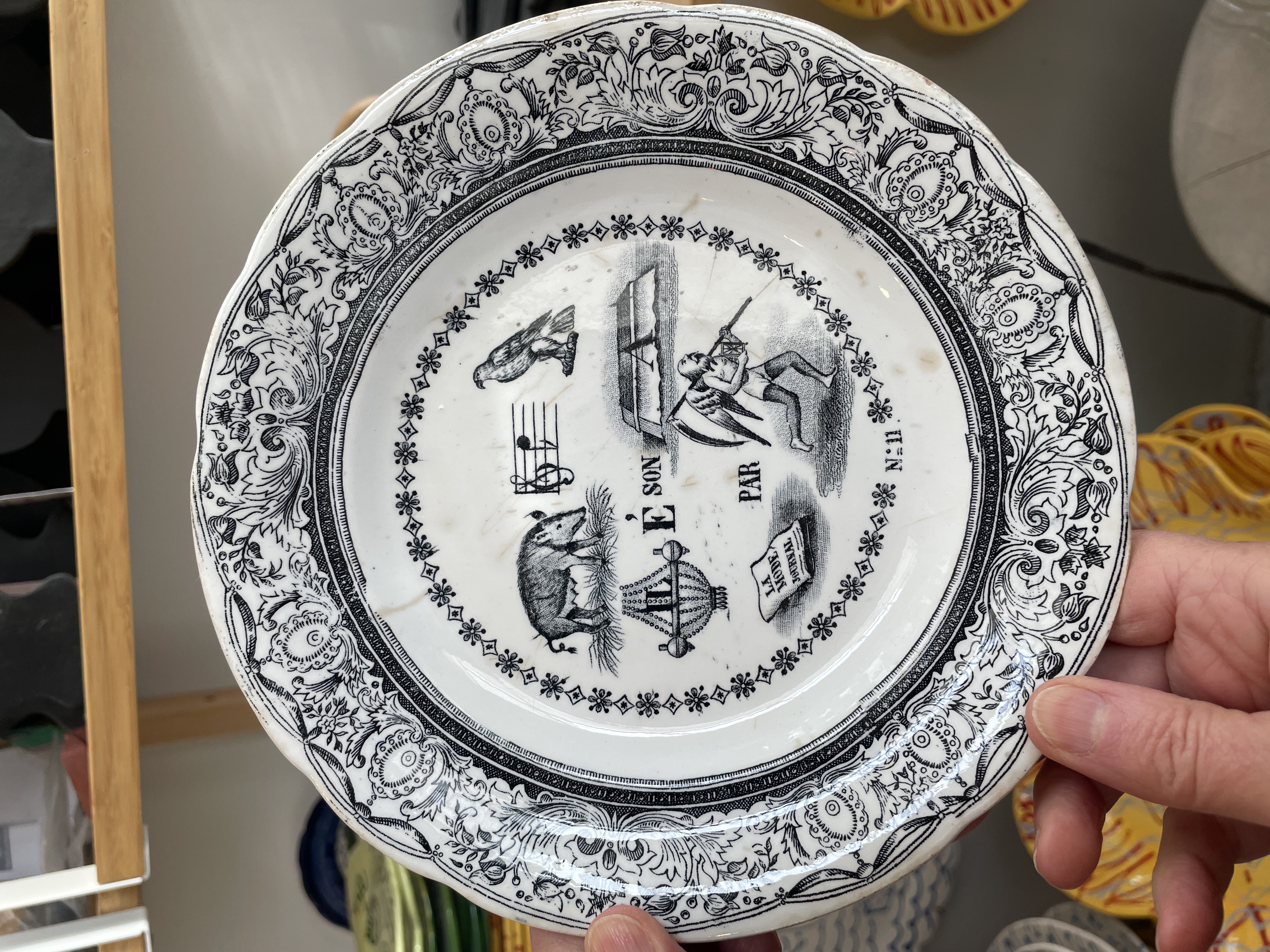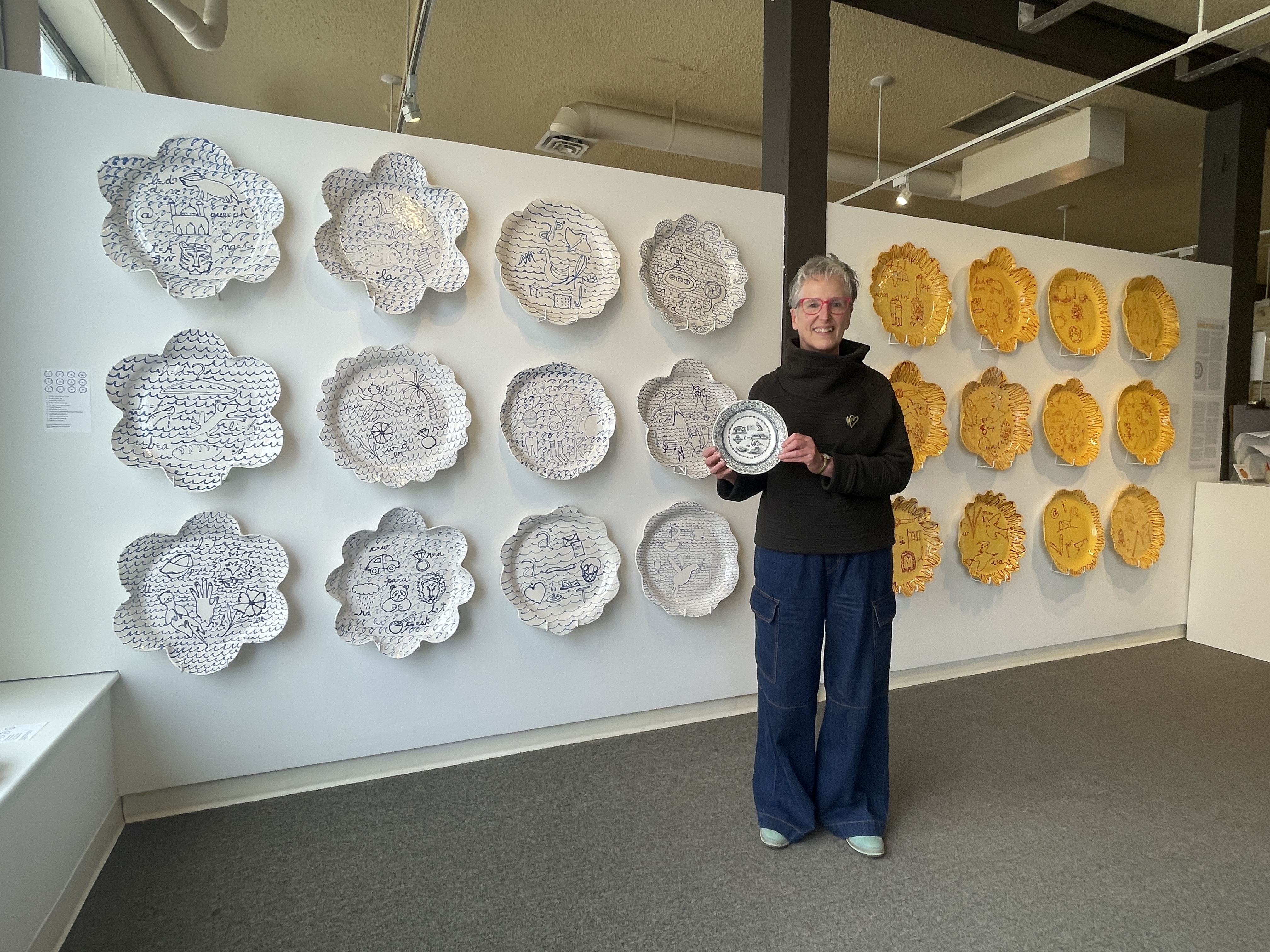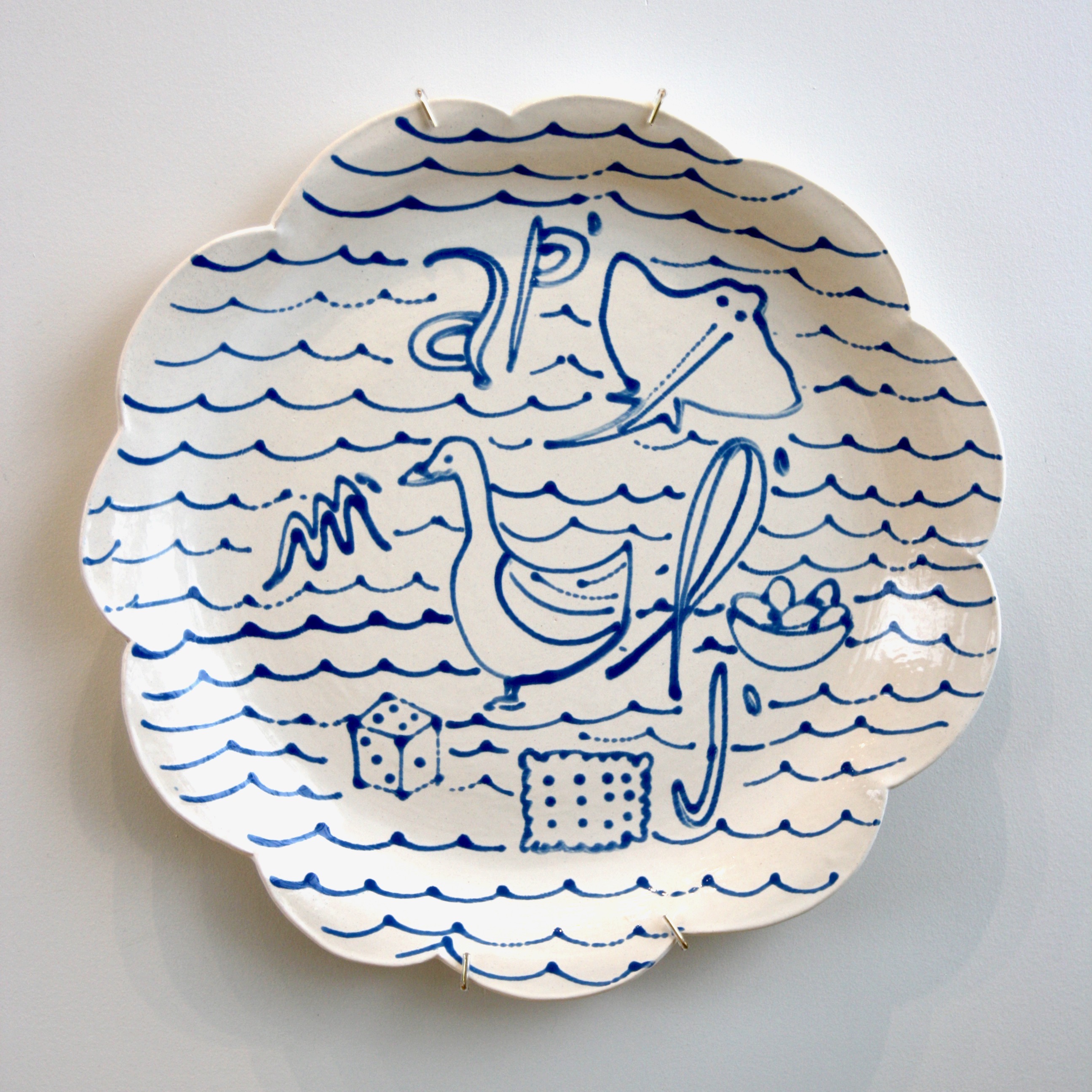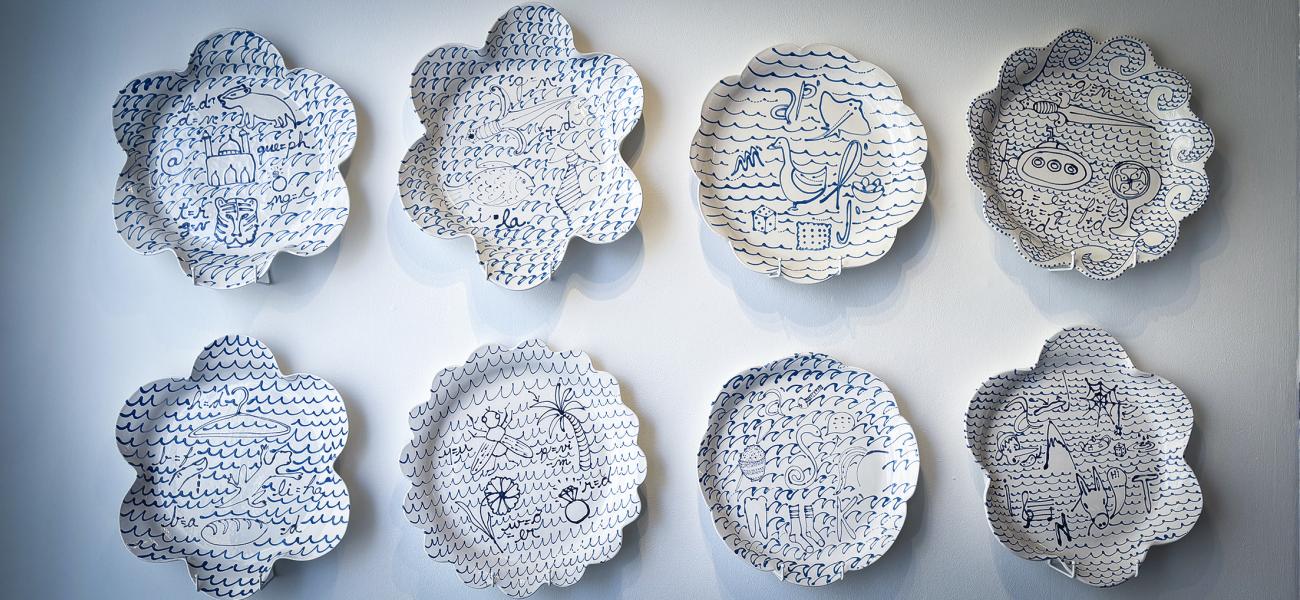Rebus Plates for Our Times
 By describing her exhibition as a rebus, the Calgary artist and art theorist Mireille Perron has deliberately thrown down the gauntlet – implying that a greater overall knowledge is behind the works – if only the viewer is willing to accept the challenge. A challenge that I welcomed when I visited her studio. I am a reader of mysteries, and the novelist Ian Rankin’s Inspector Rebus mysteries are longtime favorites. I enjoy unraveling clues and, in this case, the most obvious is the protagonist’s name – John Rebus. A rebus is perhaps best known as a visual puzzle – an enigmatic/cryptic representation of a word or phrase that uses figures or pictures to suggest the syllables of which it is made.
By describing her exhibition as a rebus, the Calgary artist and art theorist Mireille Perron has deliberately thrown down the gauntlet – implying that a greater overall knowledge is behind the works – if only the viewer is willing to accept the challenge. A challenge that I welcomed when I visited her studio. I am a reader of mysteries, and the novelist Ian Rankin’s Inspector Rebus mysteries are longtime favorites. I enjoy unraveling clues and, in this case, the most obvious is the protagonist’s name – John Rebus. A rebus is perhaps best known as a visual puzzle – an enigmatic/cryptic representation of a word or phrase that uses figures or pictures to suggest the syllables of which it is made.
When Perron was gifted with a nineteenth-century rebus plate manufactured in Gien, France, she was both thrilled and suitably puzzled. Although fluent in French and English, it took her literally years to fully decode the message, as the “translation” (usually found on the back of the plate) had been worn away. And, as her extensive research revealed, French rebuses are often more complex than their English counterparts – the first focuses on sound, the second on spelling. But the symbolic language of the rebus offers great potential for an artist. By the eighteenth century, these visual riddles took various forms and complexities, some humorous, others thoughtful. They might illustrate maxims or wise sayings or even comment on the contemporary state of affairs – social, political, economic, etc.
The seeds for this exhibition were planted two years ago when the intended meaning of her plate (fig 1) finally became clear: “Les Rebus illustrés sont fort à la mode par les temps qui court” – simply, “Illustrated rebuses are very popular in our [current] times.” Perron interpreted this as a personal challenge and was determined to create a rebus for our times. But what form would it take? Traditionally, rebus plates were transfer printed and dessert or dinner sized, as they were intended to inspire conversations around the dining table – in contrast, Perron’s plates are made and decorated (slip trailed) by hand and are huge (18”). But yes, they too are meant to trigger conversation and, hopefully, action.

 This exhibition is a cautionary tale. Together, the plates and mats recount (in two languages) a compelling narrative that addresses our mounting eco-anxiety – the fear of environmental perils. In this case, the climate crisis is sparked by the flooding and wildfires in Western Canada (and as I write this, in California). However, it was not enough for the artist to simply spell out the obvious, for, as she explains, environmental change doesn’t just affect our physical world or only those directly impacted. As the paradigm shifts to a “new normal,” so too does our everyday language. Even the once arcane rhetoric of the insurance broker – floodplains and pluvial (surface) flooding – has become commonplace. Has familiarity inspired complacency rather than urgency? [A pluvial flood occurs when an extreme rainfall event creates a flood independent of an overflowing body of water (fig 2).]
This exhibition is a cautionary tale. Together, the plates and mats recount (in two languages) a compelling narrative that addresses our mounting eco-anxiety – the fear of environmental perils. In this case, the climate crisis is sparked by the flooding and wildfires in Western Canada (and as I write this, in California). However, it was not enough for the artist to simply spell out the obvious, for, as she explains, environmental change doesn’t just affect our physical world or only those directly impacted. As the paradigm shifts to a “new normal,” so too does our everyday language. Even the once arcane rhetoric of the insurance broker – floodplains and pluvial (surface) flooding – has become commonplace. Has familiarity inspired complacency rather than urgency? [A pluvial flood occurs when an extreme rainfall event creates a flood independent of an overflowing body of water (fig 2).]
In response, the symbolic language of the rebus became Perron’s vehicle of expression. These coded works reveal how everyday language has “acclimated” and expanded. Deluge, inferno, firebrand, and flash flood are longer words we associate with distant realms. Who amongst us (in the north) was not dismayed to hear that beneath the ground, dozens of wild fires that started in 2023 are still smoldering underground (“zombie fires”) in the dead of winter, under a blanket of snow? How we now talk about and experience wildfire and flood has changed.
In the artist’s words:
“The climate crisis has brought on new phenomena that profoundly affect life on our planet. Not surprisingly, it is reflected in how we talk about and experience water and fire. Fast flood, storm tide, crown or underground wild fires are now part of our everyday vocabulary.”
Of her rebus plates, Perron explains,
“The images are painted with a trailing device – in one gesture – to emphasize that this is an urgent message, which is somewhat contradicted by the unhurried process of ceramic firing. As such, my rebus plates warn that we are acting too slowly in times of urgency.”
The outcome is a visually and intellectually exciting exhibition featuring huge colorful hand-painted ceramic plates and hooked woolen mats that “speak” to the urgency of the climate crisis. As we slowly decipher the rebuses, the fires burn and the floodwaters continue to rise! And, bringing it closer to home, like the alerts that appear on Canadian screens or through our radios, the hooked signage is bilingual; the rebus plates are in either French or English.
The theme of the exhibition is revealed in the hanging itself – literally “the writing is on the wall.” The first clues are the columns of wall-mounted hooked mats, each displaying clearly articulated signage. Octagonal and triangular signs emblazoned in orange and red wool warn of the fire condition – “ground fire” or “feu profond.” Round signs, meticulously hooked in shades of blue, give live notice of “flash flood” and “crue éclair.”
 By far the most visually exciting works are the large rebus plates. Like the mats, they are wall-mounted and the colors are descriptive (fire is portrayed in orange and red and water in blue and white). Each rebus is a compilation of line drawings and letters – the myriad objects are clear – oysters – people – even daggers, but their meaning is obscure – until one accepts the challenge and stands still until the answer emerges. The large scale of Perron’s plates is at odds with their domestic identity; nonetheless, it is fitting that perhaps the most fragile of our household goods (and those destined to be the first destroyed by flood or fire) are being used to carry these words of warning. Certainly, clay/earth transformed by fire is technically and conceptually well suited for this series. A warning for our times.
By far the most visually exciting works are the large rebus plates. Like the mats, they are wall-mounted and the colors are descriptive (fire is portrayed in orange and red and water in blue and white). Each rebus is a compilation of line drawings and letters – the myriad objects are clear – oysters – people – even daggers, but their meaning is obscure – until one accepts the challenge and stands still until the answer emerges. The large scale of Perron’s plates is at odds with their domestic identity; nonetheless, it is fitting that perhaps the most fragile of our household goods (and those destined to be the first destroyed by flood or fire) are being used to carry these words of warning. Certainly, clay/earth transformed by fire is technically and conceptually well suited for this series. A warning for our times.
While one could visit the exhibition and simply enjoy it visually, to my mind it is the engagement with the work that is most satisfying (or infuriating). In this case, the artist, Mireille Perron, has set the stage – even supplying paper and pencils to aid in deciphering the visual puzzles.
Editorial note: Rebus translations are available on some of the image captions. To view, simply hover your mouse over the image, and a pop-up will appear.


